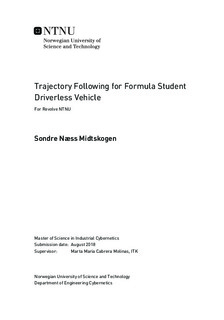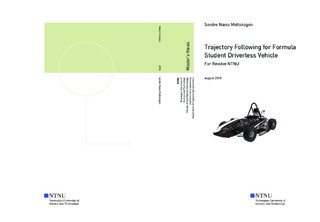| dc.description.abstract | This master s thesis is written as part of a position in Revolve NTNU Team 2018, as part of the Driverless team. The author s area of responsibility in the project is Trajectory Following. The main objective is to design, implement and test a motion control system for the driverless vehicle, along with any peripherals required to interface with neighbouring systems. Additionally it is the author s responsibility to maintain and adapt the existing driver assistance control systems and the accompanying state estimations, in the transition to a driverless vehicle.
A simple minimum viable prototype system was implemented, consisting of a Line-Of-Sight guidance controller for lateral control and a PI feedback controller with a quadratic drag feedforward term for longitudinal control. This system was very robust at low speeds.
In addition, a high-performance system was implemented in software, but was never tested on the vehicle because the upstream modules never progressed to the point where this was a sensible course of action. This system consists of a nonlinear feedback linearization lateral controller, and a PI longitudinal controller with feedforward terms for aerodynamic drag and reference speed gradient. The interface to the vehicles tractive system control system was augmented to directly accept a reference yaw rate and a longitudinal force request, which are produced by the lateral and longitudinal controllers, respectively. A longitudinal force controller was implemented to handle the latter.
A parameter estimation algorithm for the Magic Formula tire model, using the gradient search method, was implemented in order to estimate the longitudinal and lateral tire-road forces and coefficients of friction, for use in the tractive system control system. This showed good results in simulations, but requires good estimates for the tire slip ratios, which are not readily available on the physical vehicle.
Everything presented in this thesis is the author's own work, unless stated otherwise. No other party was direct involved in the development. The relevant resources at disposal for the project was software licenses for MATLAB and IPG CarMaker, the tractive system control systems already implemented by Revolve NTNU students, including the modelling of Eld and the track used for simulations, in addition to the RC-car and the Gazebo simulation. | en |

